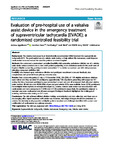Evaluation of pre-hospital use of a valsalva assist device in the emergency treatment of supraventricular tachycardia [EVADE]: a randomised controlled feasibility trial
| dc.contributor.author | Appelboam, A | |
| dc.contributor.author | Green, Jonathan | |
| dc.contributor.author | Ewings, P | |
| dc.contributor.author | Black, S | |
| dc.date.accessioned | 2020-06-06T07:44:14Z | |
| dc.date.available | 2020-06-06T07:44:14Z | |
| dc.date.issued | 2020-05-25 | |
| dc.identifier.issn | 2055-5784 | |
| dc.identifier.issn | 2055-5784 | |
| dc.identifier.other | 74 | |
| dc.identifier.uri | http://hdl.handle.net/10026.1/15738 | |
| dc.description.abstract |
<jats:title>Abstract</jats:title><jats:sec> <jats:title>Background</jats:title> <jats:p>The valsalva manoeuvre is an internationally recommended initial treatment for supraventricular tachycardia (SVT). The pre-hospital use of a valsalva assist device, to help deliver this manoeuvre, could improve cardioversion rates and reduce the need for patients to attend hospital.</jats:p> </jats:sec><jats:sec> <jats:title>Methods</jats:title> <jats:p>We conducted a randomised controlled feasibility trial comparing ambulance clinician use of a valsalva assist device versus standard care to treat adult patients presenting to an ambulance service in the south west of England. Eligible consenting participants were randomised 1:1 to device or standard care with trial procedures mirroring a proposed definitive trial.</jats:p> <jats:p>Feasibility was assessed upon ambulance clinician and participant recruitment rates and feedback, data completeness and potential future primary outcome rates.</jats:p> </jats:sec><jats:sec> <jats:title>Results</jats:title> <jats:p>Over a 6 months period (1 July to 31 December 2018), 276 (23%) of 1183 eligible ambulance clinicians were trained and they recruited 34 participants; approximately 10% of patients presenting with suspected SVT during that time. Seventeen participants were randomised to each arm and all underwent their allocated valsalva strain method. All trial data and 63/68 (93%) of pre and post-valsalva ECGs were available. Seven (21%) participants had ineligible initial rhythms on retrospective expert ECG review. Valsalva assist device use was associated with cardioversion and non-conveyance in 4 (24%) and 2 (12%) participants respectively. No participants assigned to standard care were cardioverted and all were conveyed. Participant feedback highlighted the challenges of retaining trial information during an SVT attack.</jats:p> </jats:sec><jats:sec> <jats:title>Conclusions</jats:title> <jats:p>The trial achieved efficient clinician training, randomisation and data collection, and there was an encouraging effect signal associated with device use. However, trial design changes should be considered to address the relatively small proportion of eligible patients recruited and challenges identified with consent and confirmation of cardioversion as a primary outcome.</jats:p> </jats:sec><jats:sec> <jats:title>Trial registration</jats:title> <jats:p>The trial was registered with <jats:ext-link xmlns:xlink="http://www.w3.org/1999/xlink" ext-link-type="uri" xlink:href="http://clinicaltrials.gov">ClinicalTrials.gov</jats:ext-link> (<jats:ext-link xmlns:xlink="http://www.w3.org/1999/xlink" ext-link-type="uri" xlink:href="https://clinicaltrials.gov/ct2/show/NCT03514628">NCT03514628</jats:ext-link>) on 2 May 2018.</jats:p> </jats:sec> | |
| dc.format.extent | 74- | |
| dc.format.medium | Electronic-eCollection | |
| dc.language | en | |
| dc.language.iso | en | |
| dc.publisher | Springer Science and Business Media LLC | |
| dc.subject | Emergency care | |
| dc.subject | Supraventricular tachycardia | |
| dc.subject | Valsalva assist device | |
| dc.subject | Valsalva manoeuvre | |
| dc.title | Evaluation of pre-hospital use of a valsalva assist device in the emergency treatment of supraventricular tachycardia [EVADE]: a randomised controlled feasibility trial | |
| dc.type | journal-article | |
| dc.type | Journal Article | |
| plymouth.author-url | https://www.ncbi.nlm.nih.gov/pubmed/32509319 | |
| plymouth.issue | 1 | |
| plymouth.volume | 6 | |
| plymouth.publication-status | Published | |
| plymouth.journal | Pilot and Feasibility Studies | |
| dc.identifier.doi | 10.1186/s40814-020-00616-y | |
| plymouth.organisational-group | /Plymouth | |
| plymouth.organisational-group | /Plymouth/Faculty of Health | |
| plymouth.organisational-group | /Plymouth/Faculty of Health/School of Health Professions | |
| plymouth.organisational-group | /Plymouth/Research Groups | |
| plymouth.organisational-group | /Plymouth/Research Groups/Plymouth Institute of Health and Care Research (PIHR) | |
| plymouth.organisational-group | /Plymouth/Users by role | |
| plymouth.organisational-group | /Plymouth/Users by role/Academics | |
| dc.publisher.place | England | |
| dcterms.dateAccepted | 2020-05-14 | |
| dc.rights.embargodate | 2020-6-13 | |
| dc.identifier.eissn | 2055-5784 | |
| dc.rights.embargoperiod | Not known | |
| rioxxterms.versionofrecord | 10.1186/s40814-020-00616-y | |
| rioxxterms.licenseref.uri | http://www.rioxx.net/licenses/all-rights-reserved | |
| rioxxterms.licenseref.startdate | 2020-05-25 | |
| rioxxterms.type | Journal Article/Review |


